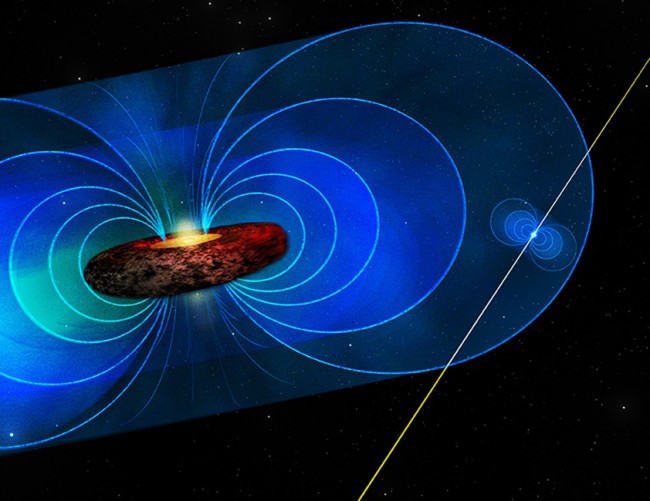The alignment of gas with the pulsar so close to the super-massive black hole has given scientists a valuable tool for understanding its magnetic field.
By NRAO, Socorro, New Mexico — Published: August 14, 2013
Astronomers have made an important measurement of the magnetic field emanating from a swirling disk of material surrounding the black hole at the center of our Milky Way Galaxy. The measurement, made by observing a recently discovered pulsar, is providing them with a powerful new tool for studying the mysterious region at the core of our galaxy.
Like most galaxies, the Milky Way harbors a supermassive black hole at its center, some 26,000 light-years from Earth. The Milky Way’s central black hole is some 4 million times more massive than the Sun. Black holes, concentrations of mass so dense that not even light can escape them, can pull in material from their surroundings. That material usually forms a swirling disk around the black hole, with material falling from the outer portion of the disk inward until it is sucked into the black hole itself.
Such disks concentrate not only the matter pulled into them but also the magnetic fields associated with that matter, forming a giant twisting magnetic field that is thought to propel some of the matter back outward along its poles in superfast “jets.”
The region near the black hole is obscured from visible-light observations by gas and dust, and is an exotic, extreme environment still little understood by astronomers. The magnetic field in the central portion of the region is an important component that affects other phenomena.
The first link to measuring the magnetic field near the black hole came last April when NASA’s Swift satellite detected a flare of X-rays from near the Milky Way’s center. Observers soon determined that the X-rays were coming in regular pulses. Follow-up observations with radio telescopes, including ones in Germany, France, and the National Science Foundation’s Karl G. Jansky Very Large Array (VLA), showed radio pulses identically spaced. The astronomers concluded the object, called PSR J1745-2900, is a magnetar, a highly magnetized pulsar, or spinning neutron star.
The pulsar is the closest yet found to the black hole, possibly within less than half a light-year. Analysis of the radio waves coming from the pulsar showed that they are undergoing a dramatic twist as they travel from the pulsar to Earth. Such a twist, called Faraday rotation, comes when the waves travel through charged gas that is within a magnetic field.
……To read the full article on the Astronomy web site click here

